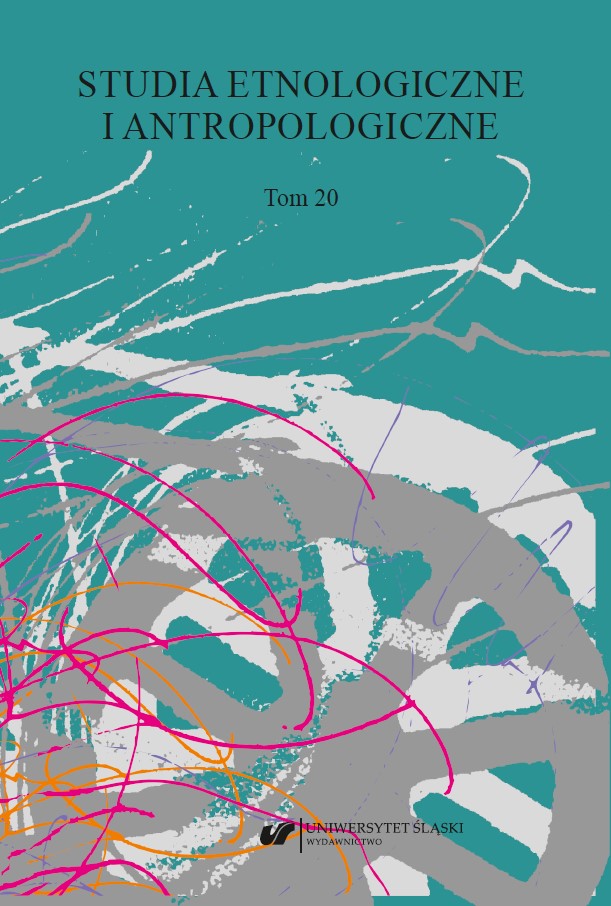Bausinger H.: Konteksty uczestnictwa w karnawale. Przeł. W. Dudzik. W: Karnawał. Studia historyczno-antropologiczne. Wybór i oprac. W. Dudzik. Warszawa 2011, s. 271–280.
Google Scholar
Bełkot A.: Karnawalizacja jako pojęcie ludyczne. „Homo Communicativus” 2008, nr 2, 45–57.
Google Scholar
Bogacki M: O współczesnym „ożywianiu” przeszłości – charakterystyka odtwórstwa historycznego. „Turystyka Kulturowa” 2010, nr 5.
Google Scholar
Braun K.: Karnawał? Karnawalizacja! W: Antropologia widowisk. Zagadnienia i wybór tekstów. Oprac. A. Chałupnik et al. Warszawa 2005, s. 415–423.
Google Scholar
Burszta W.[J.]: Rekonstrukcje historyczne. Rozmowę przepr. P. Średziński. Dziennik.pl [Gazeta Prawna]. 20.08.2016. http://wiadomosci.dziennik.pl/opinie/artykuly/529189,wojciech-burszta-wywiad-rekonstrukcje-rozmowa.html,komentarze-popularne [data dostępu: 27.02.2018].
Google Scholar
Burszta W.J.: Teraz i wtedy. Tożsamość nasycona imitacją przeszłości. W: Dziedzictwo w akcji. Rekonstrukcja historyczna jako sposób uczestniczenia w kulturze. Red. T. Szlendak. Warszawa 2012, s. 143–157.
Google Scholar
Casetti F., Odin R: Od paleo- do neo-telewizji. W perspektywie semiopragmatyki. Przeł. I. Olszewska. W: Po kinie… Audiowizualność w epoce przekaźników elektronicznych. Wybór i oprac. A. Gwóźdź. Kraków 1994, s. 117–137.
Google Scholar
Combs K.E.: Świat zabaw. Narodziny nowego wieku ludycznego. Przeł. O. Kaczmarek, Warszawa 2011.
Google Scholar
Dudzik K.: Karnawały w kulturze. Warszawa 2005.
Google Scholar
Dziekan J.: Walka postu z karnawałem, czyli caritas kontra sie ma. 2002. http://victorturner.webpark.pl/walka.htm [data dostępu: 21.05.2011].
Google Scholar
Featherstone M.: Postmodernizm i estetyzacja życia codziennego. Przeł. P. Czapliński, J. Lang. W: Postmodernizm. Antologia przekładów. Wybór i oprac. R. Nycz. Kraków 1998, s. 299–333.
Google Scholar
Hajduk-Nijakowska J.: Folkloryzm atrakcji. Wykorzystanie folkloryzmu w animacji kulturalnej w Polsce. „Etnologické Rozpravy” 2015, č. 2, s. 85–100.
Google Scholar
Hajduk-Nijakowska J.: Karnawalizacja przestrzeni miejskiej. „Etnologické Rozpravy” 2017, č. 2, s. 22–31.
Google Scholar
Kantor R.: Najnowsza historia Krakowa w ludycznych widowiskach miejskich. „Studia Etnologiczne i Antropologiczne” 2013, t. 13, s. 118–139.
Google Scholar
Kosiński D.: Teatra polskie. Rok katastrofy. Warszawa–Kraków 2013.
Google Scholar
Kowalewski M.: Protest miejski. Przestrzenie tożsamości i praktyki niezadowolonych obywateli miast. Kraków 2016.
Google Scholar
Kwiatkowski P.T.: Pamięć zbiorowa społeczeństwa polskiego w okresie transformacji. Warszawa 2008.
Google Scholar
Leščak M., Sirovátka O.: Folklor a folkloristika (O l’udovej slovesnosti). Bratislava 1982.
Google Scholar
mjz//now: Arcybiskup Jędraszewski o „tęczowej zarazie”. TVN24. 2.08.2019. https://tvn24.pl/polska/arcybiskup-marek-jedraszewski-teczowa-zaraza-zamiast-czerwonej-ra957818-2308295 [data dostępu: 20.08.2019].
Google Scholar
Nacher A.: Telepłeć. Gender w telewizji doby globalizacji. Kraków 2008.
Google Scholar
Niekludow S.J. (Неклюдов C.Ю): Фольклор современного города. W: Cовременный городской фольклор. Mocквa 2003.
Google Scholar
Pałejko J.: Czym jest Parada Równości i kto ją organizuje? Parada Równości. 9.03.2018. http://www.paradarownosci.eu/pl/aktualnosci/kto-organizuje-parade-rownoisci [dostępu: 3.04.2018].
Google Scholar
Regiewicz A.: Rekonstrukcje historyczne jako edutainment. Przypadek powstania styczniowego. „Prace Naukowe Akademii im. Jana Długosza w Częstochowie. Filologia Polska. Historia i Teoria Literatury” 2013, z. 13, s. 95–104.
Google Scholar
Schechner R.: Ulica jest sceną. W: Idem: Przyszłość rytuału. Przeł. T. Kubikowski. Warszawa 2000.
Google Scholar
Skórzyńska A.: Od karnawalizacji do teatralizacji miejskiego święta. Parada lokacyjna. „Człowiek i Społeczeństwo” 2004, t. 22: Ludyczny wymiar kultury. Red. J. Grad. H. Mamzer, s. 71–84.
Google Scholar
Skórzyńska A.: Teatr jako źródło ponowoczesnych spektakli społecznych. Poznań 2007.
Google Scholar
Sulima R.: Antropologia codzienności. Kraków 2000.
Google Scholar
Sulima R.: Demonstracja w krajobrazie kulturowym miasta. Zapiski z warszawskiej ulicy. „Konteksty. Polska Sztuka Ludowa” 2016, nr 3–4, s. 164–170.
Google Scholar
Sulima R.: Głosy tradycji. Warszawa 2001.
Google Scholar
Szlendak T.: Wehrmacht nie macha. Rekonstrukcyjna codzienność jako sposób zanurzenia w kulturze. W: Dziedzictwo w akcji. Rekonstrukcja historyczna jako sposób uczestniczenia w kulturze. Red. T. Szlendak. Warszawa 2012, s. 9–70.
Google Scholar
Szlendak T., Olechnicki K.: Nowe praktyki kulturowe Polaków. Megaceremoniały i subświaty. Warszawa 2017.
Google Scholar
Węcławiak A.: Performuj albo giń. Przystanek Woodstock jako performans kulturowy. „Amor Fati. Antropologiczne czasopismo filozoficzne” 2016, nr 1, s. 109–123.
Google Scholar
Zaremba Ł.: Obrazy wychodzą na ulice. Spory w polskiej kulturze wizualnej. Warszawa 2018.
Google Scholar
Zielińska I.: Sposoby ochrony porządku społecznego przed „skalaniem” w panikach moralnych. Weryfikacja koncepcji Mary Douglas. W: Ludzie i nie-ludzie. Perspektywa socjologiczno-antropologiczna. Red. P. Łuczecko, A. Mica. Gdańsk 2011, s. 211–229.
Google Scholar


 https://doi.org/10.31261/SEIA.2020.20.05
https://doi.org/10.31261/SEIA.2020.20.05

 10.31261/SEIA
10.31261/SEIA